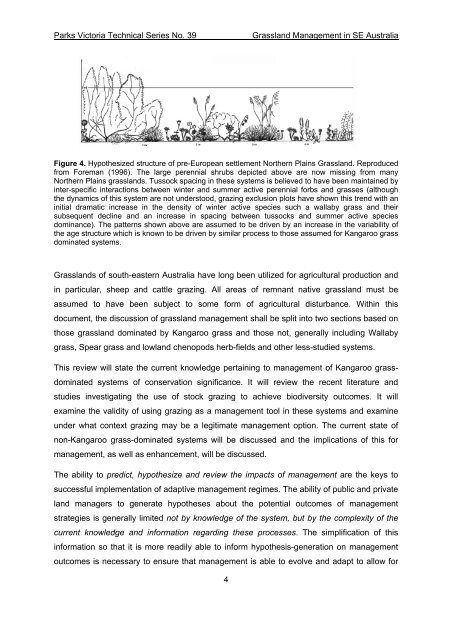Review of Grassland Management in south-eastern ... - Parks Victoria
Review of Grassland Management in south-eastern ... - Parks Victoria
Review of Grassland Management in south-eastern ... - Parks Victoria
You also want an ePaper? Increase the reach of your titles
YUMPU automatically turns print PDFs into web optimized ePapers that Google loves.
<strong>Parks</strong> <strong>Victoria</strong> Technical Series No. 39<br />
<strong>Grassland</strong> <strong>Management</strong> <strong>in</strong> SE Australia<br />
Figure 4. Hypothesized structure <strong>of</strong> pre-European settlement Northern Pla<strong>in</strong>s <strong>Grassland</strong>. Reproduced<br />
from Foreman (1996). The large perennial shrubs depicted above are now miss<strong>in</strong>g from many<br />
Northern Pla<strong>in</strong>s grasslands. Tussock spac<strong>in</strong>g <strong>in</strong> these systems is believed to have been ma<strong>in</strong>ta<strong>in</strong>ed by<br />
<strong>in</strong>ter-specific <strong>in</strong>teractions between w<strong>in</strong>ter and summer active perennial forbs and grasses (although<br />
the dynamics <strong>of</strong> this system are not understood, graz<strong>in</strong>g exclusion plots have shown this trend with an<br />
<strong>in</strong>itial dramatic <strong>in</strong>crease <strong>in</strong> the density <strong>of</strong> w<strong>in</strong>ter active species such a wallaby grass and their<br />
subsequent decl<strong>in</strong>e and an <strong>in</strong>crease <strong>in</strong> spac<strong>in</strong>g between tussocks and summer active species<br />
dom<strong>in</strong>ance). The patterns shown above are assumed to be driven by an <strong>in</strong>crease <strong>in</strong> the variability <strong>of</strong><br />
the age structure which is known to be driven by similar process to those assumed for Kangaroo grass<br />
dom<strong>in</strong>ated systems.<br />
<strong>Grassland</strong>s <strong>of</strong> <strong>south</strong>-<strong>eastern</strong> Australia have long been utilized for agricultural production and<br />
<strong>in</strong> particular, sheep and cattle graz<strong>in</strong>g. All areas <strong>of</strong> remnant native grassland must be<br />
assumed to have been subject to some form <strong>of</strong> agricultural disturbance. With<strong>in</strong> this<br />
document, the discussion <strong>of</strong> grassland management shall be split <strong>in</strong>to two sections based on<br />
those grassland dom<strong>in</strong>ated by Kangaroo grass and those not, generally <strong>in</strong>clud<strong>in</strong>g Wallaby<br />
grass, Spear grass and lowland chenopods herb-fields and other less-studied systems.<br />
This review will state the current knowledge perta<strong>in</strong><strong>in</strong>g to management <strong>of</strong> Kangaroo grassdom<strong>in</strong>ated<br />
systems <strong>of</strong> conservation significance. It will review the recent literature and<br />
studies <strong>in</strong>vestigat<strong>in</strong>g the use <strong>of</strong> stock graz<strong>in</strong>g to achieve biodiversity outcomes. It will<br />
exam<strong>in</strong>e the validity <strong>of</strong> us<strong>in</strong>g graz<strong>in</strong>g as a management tool <strong>in</strong> these systems and exam<strong>in</strong>e<br />
under what context graz<strong>in</strong>g may be a legitimate management option. The current state <strong>of</strong><br />
non-Kangaroo grass-dom<strong>in</strong>ated systems will be discussed and the implications <strong>of</strong> this for<br />
management, as well as enhancement, will be discussed.<br />
The ability to predict, hypothesize and review the impacts <strong>of</strong> management are the keys to<br />
successful implementation <strong>of</strong> adaptive management regimes. The ability <strong>of</strong> public and private<br />
land managers to generate hypotheses about the potential outcomes <strong>of</strong> management<br />
strategies is generally limited not by knowledge <strong>of</strong> the system, but by the complexity <strong>of</strong> the<br />
current knowledge and <strong>in</strong>formation regard<strong>in</strong>g these processes. The simplification <strong>of</strong> this<br />
<strong>in</strong>formation so that it is more readily able to <strong>in</strong>form hypothesis-generation on management<br />
outcomes is necessary to ensure that management is able to evolve and adapt to allow for<br />
4

















